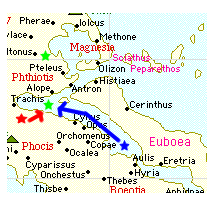
The Themistocles Gambit
(the below is only proposed and hinted to in ancient text, but it is not spelt out that it did happen. It has been suggested by today's military that the strategy suggested below might have occured.)
The Greek sailors having arrived at Artemisium, made communication with the land forces commander; Leonidas. The Thermopylae-Artemisium line was now in place.
The arrival of the Persian fleet down the coast of Greece stationed at various locations on the coastline was communicated to Leonidas. The communication back to the navy was that the Great Kings forces were still at least two days march away.
The Greeks had a few days to reorganise themselves before any action would take place...or did they?
In a council meeting Themistocles put forward that a gambit should be played out. The entire Greek navy force should withdraw from its strong position at Artemisium and head back some ways down the straight back towards Athens! The population of Euboea would not be happy with the move, but it could be done without their consent. The plan was simple enough, with the Greeks withdrawing from Artemisium, this might sucker the larger Persian navy into the confine spaces of the straights, where their superiour numbers would be nullified and the faster Greek forces had the best advantage of defeating them.
|
 
BLUE star represents the Athenian fleet and the GREEN star the advancing Persian fleet. The proposition is that the Athenian fleet is to withdraw from Artemisium and allow the Persian fleet to advance behind Leonidas at Thermopylae. If they decided to either, face the Spartans on land or attack the Athenians in the straight the advantage lies with the Greeks as Xerxes was still two days march away.
|
Historians have passed over this event as fictitious and not worth noting. The main hole in the storyline is that there is not enough to gain from allowing the Persian fleet enough space to advance down the straight and get access onto the mainland behind Leonidas' forces. The whole purpose of the Thermopylae-Artemisium line was for the navy to stop the Persian navy getting behind Leonidas and having him attacked from behind. What this view has not taken into account was that the Great King was at least two days march away from Leonidas: The Greek land forces would not be attacked on two sides.
If the Persian fleet decided to land and attack Leonidas from behind better for the Greeks on two counts. One, if the Persian navy landed to attack Leonidas it would therefor reduce the number at sea, allowing the Greek navy a great opportunity to destroy the ships beached. The Persian sailors were not of the same class as the army, Leonidas would have been eager to have a chance on taking on the Persian sailors in a phalanx battle. And two if the Persian fleet decided to come down the straight and attack the Greek navy in the confines of mainland Greece and Euboea , there would be no better place for the Greek navy to engage the Persians in a sea battle, with odds firmly stacked in the Greeks favour.
Regardless, of whether this gambit was played out or not the Persian fleet patiently waited for the arrival of their king as he requested and they did not venture into the straight.
Soon after the Greek resumed their original position.
References:

